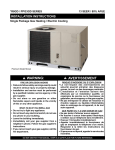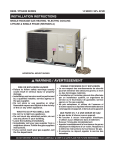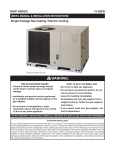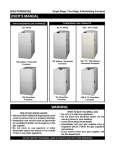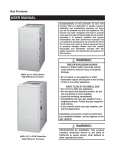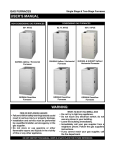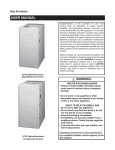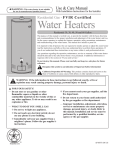Download Miller CMF95 072 PG Installation Guide
Transcript
CMF95 Series 95.1 AFUE USER’S MANUAL Downflow, Single Stage Condensing Gas Furnace IMPORTANT! Please read all information in this manual thoroughly and become familiar with the capabilities and use of your appliance before attempting to operate or maintain this unit. Pay attention to all safety warnings and any other special notes highlighted in the manual. Safety markings are used frequently throughout this manual to designate a degree or level of seriousness and should not be ignored. WARNING indicates a potentially hazardous situation that if not avoided, could result in personal injury or death. CAUTION indicates a potentially hazardous situation that if not avoided, may result in minor or moderate injury or property damage. Keep this literature where you have easy access to it in the future. If a problem occurs, check the instructions and follow recommendations given. If these suggestions don’t eliminate your problem, call your servicing contractor. Do not attempt to service this unit yourself! Under no circumstances should the appliance owner attempt to install and/or service this equipment. Some local codes require licensed installation / service personnel for this type of equipment. Improper service, adjustment, or maintenance may cause explosion, fire, electrical shock or other hazardous conditions which may result in personal injury or property damage. WARNING: FIRE OR EXPLOSION HAZARD •Failure to follow safety warnings exactly could result in serious injury or property damage. •Installation and service must be performed by a qualified installer, service agency or the gas supplier. •Do not store or use gasoline or other flammable vapors and liquids in the vicinity of this or any other appliance. WHAT TO DO IF YOU SMELL GAS •Do not try to light any appliance. •Do not touch any electrical switch; do not use any phone in your building. •Leave the building immediately. •Immediately call your gas supplier from a neighbor’s phone. Follow the gas supplier’s instructions. •If you cannot reach your gas supplier, call the fire department. AVERTISSEMENT RISQUE D’INCENDIE OU D’ EXPLOSION •Le non-respect des avertissements de sécurité pourrait entraîner des blessures graves, la mort ou des dommages matériels. •L’installation et l’entretien doivent être effectués par un installateur qualifié, un organisme de service ou le fournisseur de gazstaller, service agency or the gas supplier. •Ne pas entreposer ni utiliser de l’essence ni d’autres vapeurs ou liquides inflammables dans le voisinage de cet appareil, ni de tout autre appareil. QUE FAIRE S’IL Y A UNE ODEUR DE GAZ •Ne pas tenter d’allumer aucun appareil. •Ne toucher à aucun interrupteur électrique; n’utiliser aucun téléphone dans le bâtiment. •Évacuer l’immeuble immédiatement. •Appeler immédiatement le fournisseur de gaz en employant le téléphone d’un voisin. Respecter à la lettre les instructions du fournisseur de gaz. •Si personne ne répond, appeler le service des incendies. DO NOT DESTROY THIS MANUAL. KEEP IN A SAFE PLACE FOR FUTURE REFERENCE. For Furnaces Installed in: • Manufactured Homes • Recreational Vehicles, Park Models, & Manufactured Buildings • Modular Homes/Buildings TABLE OF CONTENTS Important SAFETY INFORMATION......... 3 Gas Supply & Piping................................... 3 Combustion Air & Venting System............... 4 Clearances to Combustibles....................... 4 Shutting Down the Furnace......................... 4 GENERAL INFORMATION............................ 5 About the Furnace....................................... 5 Air Filters..................................................... 5 Furnace in Small Room or Closet............... 5 Sources of Corrosion.................................. 5 Thermostat.................................................. 5 Warranty Information................................... 5 Maintenance............................................. 6 Blower and Filter ........................................ 6 Condensate Drainage ................................ 6 Furnace & Air Ducts.................................... 6 Venting System........................................... 6 TROUBLESHOOTING................................... 6 STARTUP & SHUTDOWN............................. 7 Starting the Furnace................................... 7 Shutting Down the Furnace......................... 7 FURNACE COMPONENTS........................... 8 2 IMPORTANT SAFETY INFORMATION WARNING: To avoid possible equipment damage, fire, or personal injury, the following instructions must be observed regarding unit maintenance and operational procedures. WARNING: PROPOSITION 65 WARNING: This product contains chemicals known to the state of California to cause cancer, birth defects or other reproductive harm. • To achieve optimum performance and minimize equipment failure, it is recommended that periodic maintenance be performed on this unit. The ability to properly perform maintenance on this equipment requires certain mechanical skills and tools. Please consult your dealer for maintenance information and availability of maintenance contracts. • The area around the gas furnace (Figure 1, page 4) and the vicinity of any other gas appliances must be kept clear and free of combustible materials, gasoline, and other flammable vapors and liquids. Do not store or use flammable items such as paint, varnish, or strippers in the vicinity of the unit. • Do not use the area around the unit as a storage area. This area must be kept clean and clear of loose or exposed insulation materials. Examine the unit’s area when it is installed or when insulation is added, since some insulation materials may be combustible. • Do not use this furnace if any part has been under water. A flood damaged furnace is extremely dangerous. Attempts to use the furnace can result in fire or explosion. A qualified service agency should be contacted to inspect the furnace and to replace all gas controls, control system parts, electrical parts that have been wet or the furnace if deemed necessary. • Familiarize yourself with the controls that shut off the gas and electrical power to the unit. IMPORTANT NOTE: If the unit needs to be shut down for an extended period of time, turn off both the gas and electrical power. For your safety always turn off both the gas and electrical power before performing service or maintenance on the furnace. If the gas supply to the unit must be shut off, refer to the shut down instructions on page 7. GAS SUPPLY & PIPING WHAT TO DO IF YOU SMELL GAS •Do not try to light any appliance. •Do not touch any electrical switch; do not use any phone in your building. •Leave the building immediately. •Immediately call your gas supplier from a neighbor’s phone. Follow the gas supplier’s instructions. •If you cannot reach your gas supplier, call the fire department. QUE FAIRE S’IL Y A UNE ODEUR DE GAZ •Ne pas tenter d’allumer aucun appareil. •Ne toucher à aucun interrupteur électrique; n’utiliser aucun téléphone dans le bâtiment. •Évacuer l’immeuble immédiatement. •Appeler immédiatement le fournisseur de gaz en employant le téléphone d’un voisin. Respecter à la lettre les instructions du fournisseur de gaz. •Si personne ne répond, appeler le service des incendies. WARNING: All gas piping and shutoff valves must be installed in compliance with local codes and utility regulations by licensed installers. DO NOT attempt to modify, or tap into existing gas lines yourself. Fire or explosion may result causing property damage, personal injury or loss of life. Failure to follow the safety warnings exactly could result in serious injury, death or property damage. WARNING: The furnace was shipped from the factory equipped to operate on natural gas. Conversion to LP/propane gas must be performed by a licensed HVAC technician using a factory supplied conversion kit. Failure to use the proper conversion kit can cause fire, explosion, property damage, carbon monoxide poisoning, personal injury, or death. This furnace does not have a pilot. It is equipped with an ignition device which automatically lights the burner. DO NOT light the burner by hand. 3 IMPORTANT SAFETY INFORMATION IMPORTANT NOTE: Should the gas supply fail to shut off or if overheating occurs, shut off the gas valve to the furnace before shutting off the electrical supply! COMBUSTION Air & VENTING SYSTEM For proper and safe operation, this furnace requires unrestricted airflow for combustion and ventilation. Do not block or obstruct air openings on the furnace, air openings around the furnace area or the spacings around the furnace. WARNING: It is extremely important that the furnace receives an unobstructed flow of clean, fresh air to properly burn the fuel gas. If this flow of air is restricted, the partially burned combustion gases may create dangerous amounts of carbon monoxide - a colorless, odorless gas that is a deadly poison that can cause personal injury or death This could create the production of excessive amounts of Carbon Monoxide - a colorless, odorless gas that is a deadly poison that could result in serious personal injury or death. Do not block any openings that are supplying fresh air to the room or closet the furnace is in. If your furnace obtains its air through a pipe to the outdoors, do not allow the inlet of the pipe to become blocked. • Air openings on top of the furnace and openings in closet doors or walls must never be restricted. If the furnace is operated without adequate air for combustion, the flame roll-out switch will open, turning off the gas supply to the burners. This indicates that a serious problem with the burners has occurred and must be corrected immediately. Only a licensed HVAC technician can reset this switch. • Your furnace and its venting system should be inspected annually by a licensed HVAC technician. The filter should be inspected at least once a month. See also the Maintenance Instructions on pages 6 - 7. • Before you remodel a room near the furnace, consult with a local code official or the National Fuel Gas Code to make sure you will be in compliance with supplying adequate air for combustion. By erecting new walls, it is sometimes possible to inadvertently restrict the furnace’s air supply. You can find more information about supplying combustion air in the NFGC, which is available at many libraries. 4 CLEARANCES TO COMBUSTIBLES The furnace is designed to have certain clearances to combustible items such as wood, paper, etc. Some types of insulation are combustible. If your furnace is installed in an attic, near unfinished walls, or in other insulated space, keep area surrounding the furnace free of insulating material. WARNING: Do not place combustible materials on or against the furnace cabinet or vent pipe. The area around the furnace must be kept clear and free of combustible materials, gasoline and other flammable vapors and liquids. A fire or explosion may result causing property damage, personal injury or loss of life. Failure to follow the safety warnings exactly could result in serious injury, death or property damage. Furnace CLEARANCES CLOSET ALCOVE 1" 0” 0” 6” 0” 1" 0” 0” 6” 0” Front Rear Sides Top Vent REAR LEFT SIDE RIGHT SIDE VENT FRONT Figure 1. Minimum Clearances SHUTTING DOWN THE FURNACE If you need to shut down your furnace for service or maintenance, shut off the gas valve to the furnace before shutting off the electrical service. Remove the door panel from the front of the furnace and turn the knob to the OFF Position. Additional instructions for shutting down the furnace can be found on page 7. If your installation has a manual gas shutoff valve on the gas supply pipe, shut this off, then shut off the electric to the furnace. GENERAL INFORMATION About the Furnace • This furnace has been tested for capacity and efficiency in accordance with A.H.R.I. Standards and will provide many years of safe and dependable comfort, providing it is properly installed and maintained. With regular maintenance, this unit will operate satisfactorily year after year. Abuse, improper use, and/or improper maintenance can shorten the life of the appliance and create unsafe hazards. • This furnace is designed to fulfill the requirements of being classified as a Category IV furnace. This classification is related to the furnace’s Annual Fuel Utilization Efficiency (AFUE) rating, the percentage of fuel that is converted into usable heating energy. • Category IV furnaces typically have an AFUE rating over 90% and are mainly vented through plastic PVC pipe. Air FILTERS WARNING: Never operate the furnace without a filter in place. Accumulating dust in the return air can build up on internal components, resulting in loss of efficiency, equipment damage, and possible fire. • An air filter is supplied with the furnace as shipped from the factory. • The furnace should always have a clean filter. If the filter becomes dirty, it should be cleaned or replaced. The filter is installed over the return air grille of the door inside the furnace cabinet. • New or newly renovated homes may require more frequent changing or cleaning until the construction dust has minimized. Filters designed to remove smaller particles such as pollen, may require additional maintenance. FURNACE IN A SMALL ROOM OR CLOSET If a furnace is installed in relatively small utility room or closet, the installation needs openings in the walls or door to let return air in. Make sure that these openings remain unobstructed. Do not modify these openings in any way without consulting a licensed HVAC technician. SOURCES OF CORROSION It is known that certain common household chemicals can cause heat exchanger corrosion if the vapors are pulled into the furnace’s burners The following is a list of chemicals that should not be used or stored near the furnace. Do not store these chemicals near the furnace: • Gasoline/Kerosene • Permanent wave solutions • Chlorinated waxes and cleaners • Chlorine based swimming pool chemicals • Water softening chemicals • De-icing salts or chemicals • Carbon tetrachloride • Halogen type refrigerants • Cleaning solvents (perchloroethylene) • Printing inks, paint removers, varnishes, etc. • Hydrochloric acid • Cements and glues • Antistatic fabric softeners • Masonry acid washing materials THERMOSTAT • This single stage gas furnace is designed to be controlled by a conventional single stage thermostat. The thermostat’s wiring must comply with the current provisions of the NEC (ANSI/NFPA 70) and with applicable local codes having jurisdiction. Thermostat connections should be made in accordance with the instructions supplied with the thermostat and the indoor equipment. • The thermostat should be mounted about 5 feet above the floor on an inside wall and not on an outside wall or other location where its operation may be adversely affected by radiant heat from fireplaces, sunlight, or lighting fixtures, and convective heat from warm air registers or electrical appliances. • Thermostat styles vary. Please refer to the thermostat manufacturer’s User Manual for detailed programming instructions. Warranty Information A warranty certificate with full details is included with the equipment. Carefully review these responsibilities with your dealer or service company. The manufacturer will not be responsible for any costs found necessary to correct problems due to improper setup, improper installation, adjustments, improper operating procedure on the part of the user, Some specific examples of service calls which are not included in the limited warranty are: • Correcting wiring problems in the electrical circuit supplying the equipment. • Resetting circuit breakers or other switches. • Adjusting or calibrating of thermostat. 5 Maintenance Information Proper maintenance is important to achieve optimum performance from the furnace. This equipment should be inspected annually by a licensed HVAC technician. Table 1 (page 7) contains suggested inspections and frequency of maintenance. Routine maintenance should include the following: BLOWER & FILTER • Never operate the furnace without a filter in place. Dust and lint can build up on internal components, resulting in loss of efficiency, equipment damage, and possible fire. • Keep air filters cleaned. Filters should be changed or cleaned monthly during the heating/cooling season. Clean or replace filter to maintain proper airflow and achieve maximum efficiency. Newly built or renovated homes may require more frequent changing until the construction dust has minimized. Filters designed to remove smaller particles such as pollen, may require additional maintenance. • It is recommended that the blower compartment be cleaned of dirt or lint that may have accumulated in the compartment or on the blower and motor as part of the annual inspection. Condensate Drainage • This furnace produces liquid condensate which is slightly acidic. The vent pipe must be sloped upwards away from the furnace to properly drain the water back into the condensate disposal system. • Condensate drain tubes must maintain a downward slope to ensure proper drainage. Periodically inspect the condensate drain tube for proper drainage. Also, do not place heavy objects on the tubing that restricts the flow of condensate. FURNACE & AIR DUCTS • Homeowners should perform frequent visual inspections of the furnace for obvious signs of deterioration. The furnace should be sound without sagging, cracks gaps, etc around the base. The return air duct connection(s) is secured and sealed to the furnace cabinet and terminates outside the area containing the furnace. Any signs of damage or loose connections should be repaired by a qualified HVAC technician. • Furniture and drapery should be arranged so that the supply air registers and return grilles are not obstructed. • If house is newly built, the operation of a gas furnace in a construction environment can cause a variety of problems with the furnace. Before occupying the residence, homeowners should have these safety inspections performed by a licensed technician: 6 – The filter must be replaced (or cleaned) and the furnace must be inspected by a licensed HVAC technician. –The furnace must be cleaned and/or repaired if found to be dirty, damaged, or malfunctioning in any way. – Before occupancy, the furnace shall be inspected and approved by applicable local authority even if this results in redundant inspections. –The duct work must be inspected and cleaned if found to contain any construction debris. VENTING SYSTEM • For proper and safe operation, the furnace needs air for combustion and ventilation. Do Not block or obstruct air openings on the furnace, or any air openings where the furnace may be installed, including any surrounding spaces. • Direct vent furnaces pull combustion air from the outdoors and vent combustion products back outside. Combustion air coming from the outside needs to be clean of chemicals that can cause corrosion, such as pool chlorinating products. • Vent pipe must slope upwards and be physically sound without holes or corrosion. Any corroded section of vent pipe must be replaced, and any obstruction or blockage must be removed by a licensed HVAC technician. • Flue passageways, the vent system, and the burners should be inspected and cleaned (if required) by a licensed HVAC technician annually to ensure continued safe operation. TROUBLESHOOTING If the furnace fails to operate check the following: 1.Is the thermostat setting correct? 2.Is the ON / OFF switch inside the front door turned on? See Figure 3 (page 8) for switch location. 3.Is the circuit breaker tripped? 4.Is the gas turned on at the manual shutoff? 5.Is the filter dirty or clogged? If the furnace still doesn’t operate, contact a licensed HVAC technician FREQUENCY OF MAINTENANCE MAINTENANCE ITEM BEGINNING OF EACH HEATING SEASON Verify furnace area is free of combustible materials. Verify combustion and ventilation air is not restricted. X X END OF EACH MONTHLY HEATING SEASON X X X X X Verify no signs of physical deterioration of the furnace. X X Verify no obstructions or restrictions in vent or chimney. X X Verify no holes or cracks in vent pipe. X X Verify no corrosion in vent pipe. X X Verify the horizontal vent pipes slope upwards away from the furnace. X X Clean or replace filter(s). X Maintenance items below should be perfomed by qualified service person. Verify burner flame. X Clean blower compartment. X Clean burner assembly. Clean condensate collection & disposal system (if applicable). X X Table 1. Maintenance Table STARTUP & SHUTDOWN STARTING THE FURNACE 1.Make sure the filter is clean and in place. 2.Make sure the vent system is properly installed. 3.Set the thermostat to the lowest setting. 4.Close the manual gas valve outside the furnace. 5.Turn off all electric to the furnace. 6.Remove the door from the burner compartment. 7.Set the gas valve On/Off knob to the OFF position. See Figure 2 for gas valve knob location. 8.Wait 5 minutes. If there is any smell of gas, see “WHAT TO DO IF YOU SMELL GAS” on page 3. 9.Set the gas valve On/Off knob to the ON position. 10.Turn on all electric to the furnace, including the ON / OFF switch. See Figure 3 (page 8) for switch location. 11.Open the manual gas valve. 12.Turn the thermostat back up to force ignition. 13.Observe operation, including burners. If burners fail to ignite, call a licensed HVAC technician. 14.Replace the door on the burner compartment. SHUTTING DOWN THE FURNACE If you need to shut down your furnace for service or maintenance, follow these steps: 1.Set the thermostat to the lowest setting. 2.Close the manual gas valve outside the furnace. 3.Turn electric to the furnace off. 4.Open the door to the burner compartment. 5.Set the ON /OFF switch to OFF. See Figure 3 (page 8) for switch location. 6.Set the gas valve On/Off knob to the OFF position. See Figure 2 below for knob location. 7.Replace the door on the burner Compartment. OFF Position ON / OFF Knob ON Position Figure 2. Gas Valve 7 furnace components The furnace components shown in Figure 3 will help identify and locate various parts of the furnace. The component you need to familiarize yourself with is the gas valve. You will use this to turn the furnace on and off. There are no user serviceable parts. All repairs must be done by a licensed HVAC technician. Exhaust Vent Pipe Blower Assembly ON / OFF Switch Control Board Inline Drain Assembly Inducer Assembly Combustion Air Pipe Limit Switch Gas Valve 24V Transformer Main Air Limit Switch Igniter Flame Sensor Roll-Out Switch Gas Manifold & Burner Assembly Figure 3. CMF95 Furnace Components Specifications & illustrations subject to change without notice or incurring obligations. O’ Fallon, MO | Printed in U.S.A. (05/12) 7094390 (Replaces 709250B)








